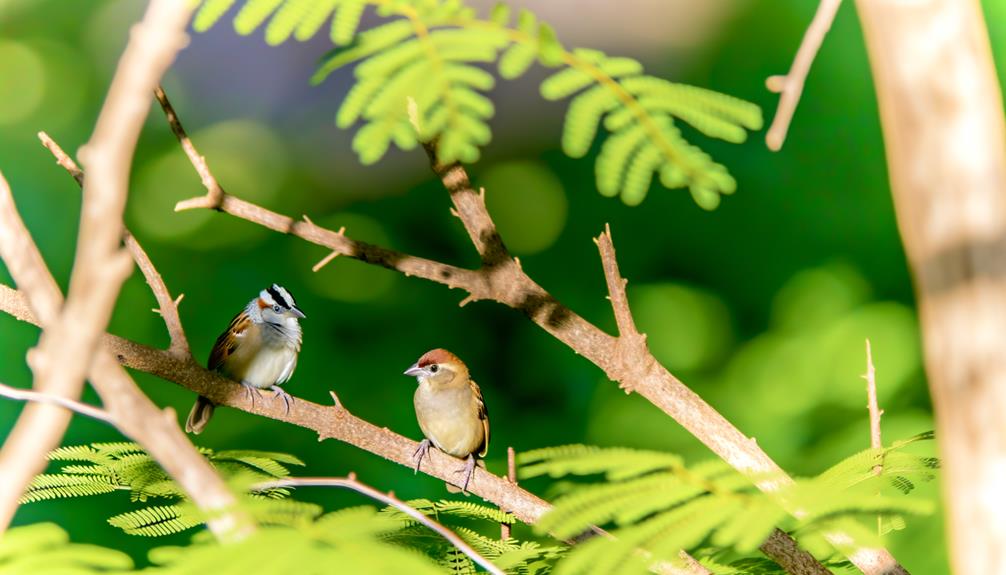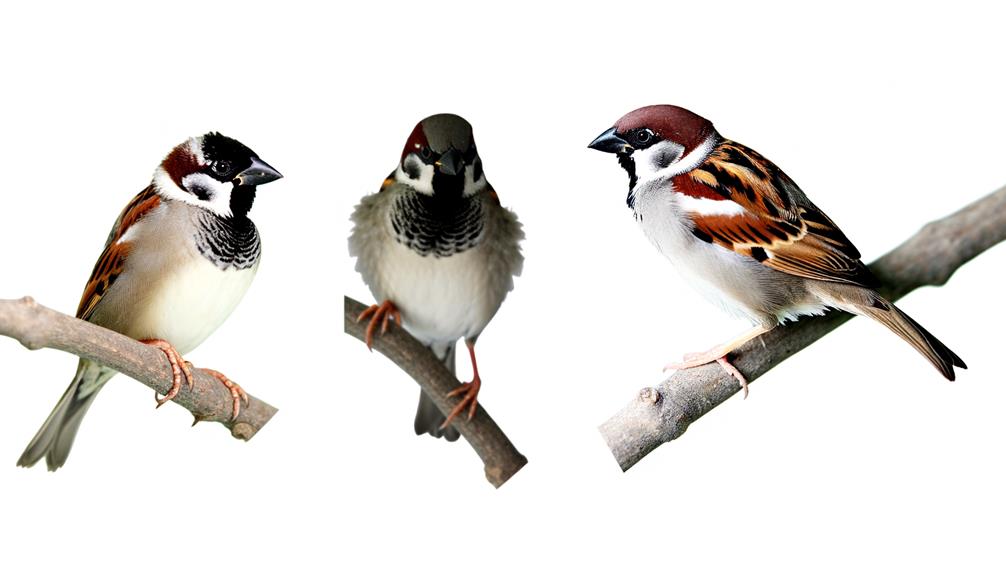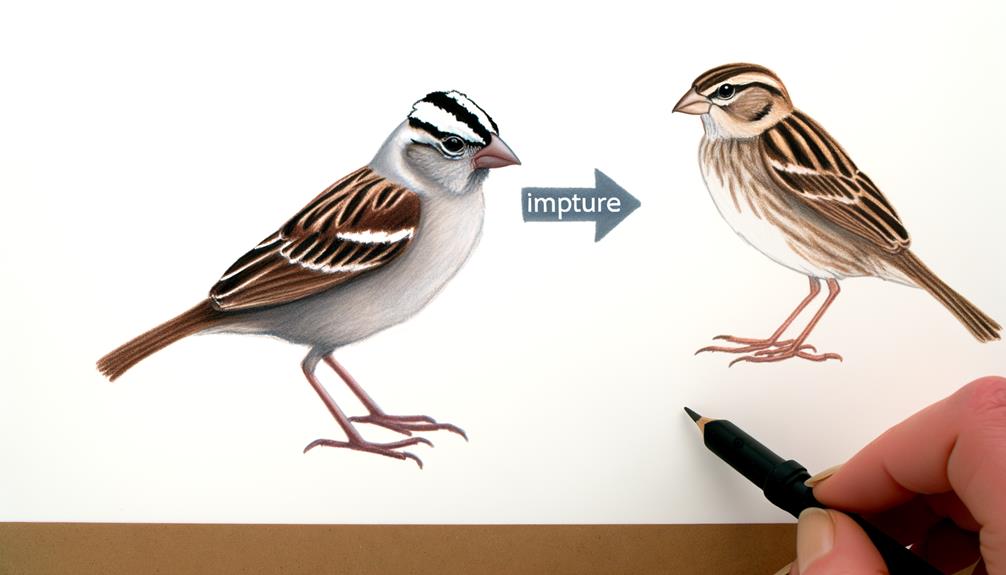3 Key Differences Between Immature White-Crowned Sparrow vs Field Sparrow
Distinguishing the immature White-crowned Sparrow from the Field Sparrow entails noting key differences. The immature White-crowned Sparrow has black and white head stripes, a 2-3 mm crown stripe, and a robust body measuring 15-17 cm in length.
It also features an orange bill and streaked brownish-gray plumage. In contrast, the Field Sparrow displays a plain face, a pinkish bill approximately 7-9 mm in length, and buff-toned plumage with lighter wings and a pinkish chest, all within a 15 cm slender frame.
Their respective songs and habitat preferences also differ markedly, providing further identification clues. For a detailed understanding, additional details await.

Key Takeaways
- Immature White-crowned Sparrows have black and white head stripes, while Field Sparrows have a plain face.
- White-crowned Sparrows have a robust body and conical beak; Field Sparrows are slender with a delicate, pinkish beak.
- White-crowned Sparrows exhibit systematic foraging and aggressive territorial defense; Field Sparrows prefer open spaces and are more social.
- White-crowned Sparrows nest above ground; Field Sparrows nest on the ground concealed by grasses or shrubs.
- White-crowned Sparrows have complex songs; Field Sparrows' songs are simpler and whistled.
Physical Appearance

The immature White-crowned Sparrow exhibits distinct black and white stripes on its head, while the Field Sparrow is characterized by a plain, unmarked face and a pinkish bill.
The White-crowned Sparrow's crown stripes measure approximately 2-3 millimeters in width, starkly contrasting with its grayish-brown body plumage. Its bill is typically orange, providing a sharp contrast against the head pattern.
Observers note that the Field Sparrow's bill measures around 7-9 millimeters in length, complementing its generally unadorned facial features.
The overall body length of the immature White-crowned Sparrow ranges from 15-17 centimeters, whereas the Field Sparrow exhibits a more modest length of 12-14 centimeters.
These precise distinctions help ornithologists and bird enthusiasts alike to identify each species accurately in their natural habitats.
Plumage Differences
In addition to their distinct head patterns, immature White-crowned Sparrows and Field Sparrows exhibit noticeable differences in their overall plumage coloration and texture.
The immature White-crowned Sparrow displays a more subdued, brownish-gray plumage with pronounced streaks across its back and flanks. These streaks provide a camouflage effect, aiding in predator evasion.
Conversely, the Field Sparrow features a cleaner, buff-toned plumage, with less streaking and a subtly pinkish hue on its chest. Their wing feathers are noticeably lighter, giving them a softer appearance. The comparative lack of streaking in Field Sparrows results in a sleeker, more uniform look.
Such differences in plumage not only assist in species identification but also reflect their unique ecological adaptations.
Size and Shape

Regarding size and shape, the immature White-crowned Sparrow generally measures around 17 centimeters in length, displaying a more robust body compared to the Field Sparrow's slender 15-centimeter frame.
The White-crowned Sparrow's beak is conical and stout, while the Field Sparrow presents a more delicate, pinkish beak.
Furthermore, the wings and tail of the White-crowned Sparrow are proportionally longer and broader, contributing to its distinctive flight profile.
Overall Body Size
Researchers note that immature White Crowned Sparrows typically exhibit a more robust body size compared to Field Sparrows, with an average length of approximately 6.3 inches versus 5.5 inches, respectively.
This difference in size is evident in the following aspects:
- Weight: Immature White Crowned Sparrows average around 30 grams, while Field Sparrows weigh closer to 12 grams.
- Wing Span: White Crowned Sparrows have a wingspan averaging 9.4 inches, whereas Field Sparrows measure about 7.5 inches.
- Body Shape: The White Crowned Sparrow's body is more stout and rounded, contrasting with the more slender and streamlined Field Sparrow.
These measurements underpin the distinct physical characteristics that separate these two bird species, offering valuable insights for ornithologists and bird enthusiasts alike.
Beak and Head Shape
Turning attention to the beak and head, immature White Crowned Sparrows exhibit a noticeably broader and more robust beak compared to the more delicate and tapered beak of Field Sparrows. The White Crowned Sparrow's beak measures approximately 8-10 mm in width, offering a sturdy structure ideal for cracking seeds.
In contrast, the Field Sparrow's beak, measuring around 6-8 mm in width, presents a more streamlined form, suitable for their insectivorous diet. The head shape further distinguishes these species: White Crowned Sparrows have a more rounded and pronounced cranial profile, while Field Sparrows display a more streamlined and less pronounced cranial contour.
These morphological differences are essential for their respective ecological niches and foraging behaviors.
Wing and Tail Length
White Crowned Sparrows possess wings averaging 70-75 mm in length, offering greater flight stability, whereas Field Sparrows exhibit slightly shorter wings, measuring around 65-70 mm, which are optimized for agile maneuvering in dense vegetation.
The tail length of these species further distinguishes their flight capabilities. White Crowned Sparrows have longer tails, typically 65-70 mm, aiding in sustained flight. In contrast, Field Sparrows' tails measure around 55-60 mm, enhancing their agility in cluttered habitats.
- Wing Length: White Crowned Sparrows (70-75 mm) vs. Field Sparrows (65-70 mm)
- Tail Length: White Crowned Sparrows (65-70 mm) vs. Field Sparrows (55-60 mm)
- Flight Adaptations: Stability for White Crowned Sparrows vs. Maneuverability for Field Sparrows
Understanding these measurements illuminates their distinct ecological niches.
Song and Calls
How do the song and calls of the immature White-crowned Sparrow differ from those of the Field Sparrow regarding frequency range, syllable structure, and duration? The immature White-crowned Sparrow exhibits a broader frequency range, often spanning from 2 kHz to 8 kHz. In contrast, the Field Sparrow's song typically ranges from 3 kHz to 7 kHz. Syllable structure in the White-crowned Sparrow's song is more complex with varying pitch, while the Field Sparrow's song features a simpler, whistled structure. Duration also varies, with the White-crowned Sparrow's song lasting up to 3 seconds, whereas the Field Sparrow's song usually lasts around 2 seconds.
| Species | Frequency Range | Song Duration |
|---|---|---|
| White-crowned Sparrow | 2 kHz – 8 kHz | Up to 3 sec |
| Field Sparrow | 3 kHz – 7 kHz | Around 2 sec |
These differences highlight their distinct vocal characteristics.
Behavior Patterns

While their vocalizations reveal clear differences, the immature White-crowned Sparrow and Field Sparrow also exhibit distinct behavior patterns. The White-crowned Sparrow demonstrates a more systematic foraging approach, often seen meticulously searching leaf litter. In contrast, the Field Sparrow prefers open spaces, hopping energetically between grass stems. Observational data highlights their unique behavioral characteristics:
- Foraging Technique: White-crowned Sparrows systematically search for insects and seeds, whereas Field Sparrows employ a rapid, erratic hopping.
- Territorial Displays: White-crowned Sparrows show more aggressive territorial defense, frequently engaging in chases and vocal confrontations.
- Social Interaction: Field Sparrows display higher social tolerance, often forming small, loose flocks outside breeding season.
These behavior patterns underscore their ecological adaptations and strategies for survival, reflecting their distinct evolutionary paths.
Habitat Preferences
Immature White Crowned Sparrows and Field Sparrows exhibit distinct habitat preferences, observable in their preferred nesting sites, seasonal migration patterns, and vegetation and foraging behaviors.
Detailed observations indicate White Crowned Sparrows favor brushy, open areas with ample ground cover, while Field Sparrows choose grasslands with sparse shrubbery.
Seasonal migration data reveal significant differences, with White Crowned Sparrows migrating over longer distances compared to the relatively sedentary Field Sparrows.
Preferred Nesting Sites
Preferring brushy fields and open woodlands, the White-crowned Sparrow often nests in dense shrubs, while the Field Sparrow typically selects grassy areas and meadows for its nesting sites.
White-crowned Sparrows demonstrate a preference for thickets and low-lying vegetation, ensuring concealment and protection from predators. Field Sparrows, on the other hand, favor open habitats with sparse vegetation, facilitating easy access to seeds and insects.
Key characteristics of their nesting sites include:
- White-crowned Sparrow: Nests are usually located 0.3 to 1.2 meters above ground.
- Field Sparrow: Ground nests are often concealed by tall grasses or shrubs.
- Both species: Utilize natural materials like grass, twigs, and feathers for nest construction.
Their distinct habitat preferences reflect their adaptive strategies for survival and reproduction.
Seasonal Migration Patterns
Understanding their nesting preferences, both the White-crowned Sparrow and the Field Sparrow exhibit distinct seasonal migration patterns that align with their habitat needs throughout the year.
The White-crowned Sparrow migrates extensively, traveling from northern breeding grounds in Alaska and Canada to wintering habitats in the southern United States and Mexico. Quantitative observations indicate that White-crowned Sparrows prefer open woodlands and shrubby areas during migration.
Field Sparrows, in contrast, display partial migration, with northern populations moving southward to milder climates, while southern populations remain resident year-round. Field Sparrows favor grasslands and open fields as their preferred habitats.
Seasonal shifts in temperature and food availability are key drivers in their migration patterns, ensuring these species occupy ideal habitats for survival and reproduction.
Vegetation and Foraging
White-crowned Sparrows and Field Sparrows display distinct habitat preferences. The former frequently forages in shrubby areas and open woodlands, while the latter often seeks out grasslands and open fields. Observational studies indicate that White-crowned Sparrows exhibit a preference for habitats with dense vegetation, which provides ideal cover and diverse food sources.
In contrast, Field Sparrows demonstrate a marked inclination toward open, grassy environments where sparse vegetation allows for efficient ground foraging.
- White-crowned Sparrows: Prefer shrubby areas, open woodlands.
- Field Sparrows: Favor grasslands, open fields.
- Vegetation Density: White-crowned Sparrows thrive in dense foliage; Field Sparrows prosper in sparse vegetation.
These habitat preferences underscore each species' adaptive strategies for survival, illustrating their unique ecological niches and foraging behaviors.
Seasonal Variations

Seasonal variations greatly influence the migratory patterns, molting schedules, and habitat preferences of both immature White-crowned Sparrows and Field Sparrows.
In spring, White-crowned Sparrows undertake extensive northward migrations, traveling up to 2,600 miles. Field Sparrows, in contrast, display more localized movements, often wintering within the same region.
Molting patterns also differ; White-crowned Sparrows complete a prebasic molt post-breeding, while Field Sparrows exhibit a more gradual molt.
Habitat preferences shift seasonally—White-crowned Sparrows favor open fields and shrublands in breeding seasons, while Field Sparrows frequent grasslands and open woods.
Precise measurements of these behaviors reveal adaptive strategies driven by environmental pressures, showcasing the dynamic interplay between biology and seasonal change. Both species exemplify resilience and adaptability.
Conclusion
In the intricate dance of nature, the immature white-crowned sparrow and the field sparrow symbolize unique brushstrokes on the canvas of avian diversity. Each, with its distinct plumage, size, and song, weaves its own narrative within varied habitats.
Seasonal shifts amplify these nuances, showcasing the dynamic interplay of adaptation and survival. Through precise measurements and detailed observations, the essence of these sparrows illuminates the delicate balance and beauty inherent in our natural world.






